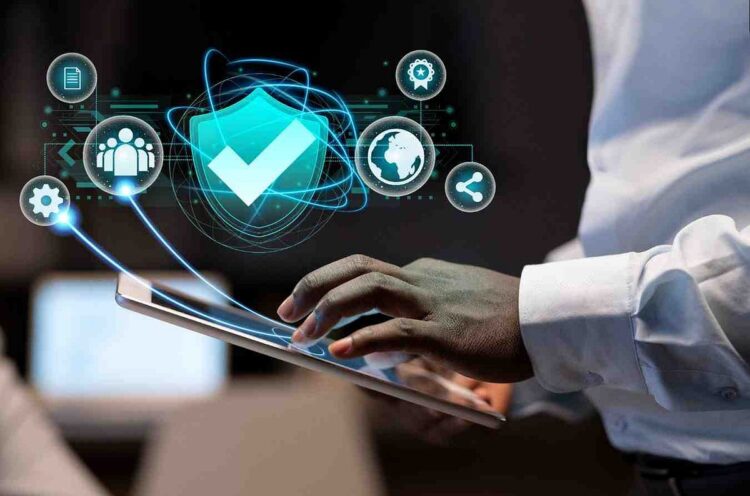The Foundational Pillars of Digital Defense
A solid cybersecurity architecture is built upon several critical components that work together to protect the network, endpoints, data, and users. These components aren’t isolated tools, but integrated layers of defense that ensure continuous monitoring, detection, and response.
1. Endpoint Protection Solutions
Endpoints—laptops, desktops, servers, and mobile devices—are the primary targets for cybercriminals and often represent the easiest point of entry into an organization’s network. Effective endpoint protection has evolved far beyond traditional antivirus.
A. Next-Generation Antivirus (NGAV)
Modern threats, such as zero-day attacks and fileless malware, can easily evade older, signature-based antivirus software. NGAV utilizes advanced techniques like machine learning, behavioral analysis, and artificial intelligence to detect and block both known and novel threats based on their behavior rather than just matching a known signature. This proactive approach is vital for stopping sophisticated ransomware and targeted attacks before they can execute.
B. Endpoint Detection and Response (EDR)
EDR tools take protection a step further than NGAV. They continuously monitor all activity on endpoints, record the data, and provide security teams with the context necessary to identify, investigate, and swiftly respond to security incidents.
- Continuous Monitoring: EDR logs and analyzes every process, file access, and network connection.
- Threat Hunting: It enables security analysts to proactively search for subtle signs of compromise that might bypass automated defenses.
- Automated Response: Upon detecting a threat, EDR can automatically isolate the compromised device, kill malicious processes, and roll back changes, significantly reducing the impact and spread of an attack.
2. Network Security and Perimeter Defense
The network perimeter is the first line of defense, serving as a gatekeeper to control the flow of traffic into and out of the corporate environment.
A. Firewalls (Next-Generation Firewalls – NGFW)
A firewall is the cornerstone of network security, acting as a barrier between your internal network and external traffic sources (like the internet). A Next-Generation Firewall (NGFW) offers far more sophisticated protection than its predecessors.
NGFW features typically include:
- Intrusion Prevention System (IPS): Actively examines network traffic flows to detect and prevent vulnerability exploits.
- Deep Packet Inspection (DPI): Analyzes the actual content of data packets, not just headers, to identify malware, viruses, and policy violations.
- Application Control: Allows administrators to manage which applications and services are permitted to run on the network.
B. Intrusion Detection and Prevention Systems (IDPS)
While IPS is often integrated into an NGFW, dedicated IDPS solutions offer more focused capabilities.
- Intrusion Detection System (IDS): Monitors network traffic for suspicious activity and sends alerts when potential threats or policy violations are detected.
- Intrusion Prevention System (IPS): Not only detects but also actively attempts to block or stop the threat from executing, often by dropping malicious packets or resetting connections.
C. Secure Web Gateways (SWG) and DNS Protection
SWG solutions sit between users and the internet, enforcing security policies and filtering out malicious content before it reaches the endpoint. They offer functions like:
- URL Filtering: Blocking access to known malicious, compromised, or inappropriate websites.
- Malware Scanning: Inspecting files downloaded from the web.
DNS Protection adds another layer by preventing users from connecting to command-and-control servers or phishing sites by filtering traffic at the Domain Name System (DNS) level.
3. Identity and Access Management (IAM)
The human element is often cited as the weakest link in the security chain. IAM tools are crucial for ensuring that only verified users have appropriate access to sensitive resources.
A. Multi-Factor Authentication (MFA)
MFA is arguably the single most impactful security measure a business can implement. It requires users to provide two or more verification factors to gain access to a resource, effectively neutralizing the threat of compromised passwords. The factors typically include:
- Something you know (e.g., a password).
- Something you have (e.g., a mobile device receiving a one-time code or a physical token).
- Something you are (e.g., a biometric scan like a fingerprint).
B. Single Sign-On (SSO)
SSO allows users to log in with a single set of credentials and gain access to multiple independent software systems. This not only improves user experience but, more importantly, enhances security by centralizing authentication and making it easier to enforce strong password and MFA policies across all business applications.
C. Privileged Access Management (PAM)
PAM solutions focus on securing, managing, and monitoring non-human accounts and privileged user accounts (like system administrators or service accounts) that have broad access to critical systems. Misuse or compromise of a privileged account can grant an attacker full control over the network, making PAM an indispensable security layer.

4. Data Protection and Encryption Technologies
Data is the ultimate target of most cyberattacks. Tools focused on protecting data ensure that even if a breach occurs, the information remains unusable to unauthorized parties.
A. Encryption Tools
Encryption transforms readable data (plaintext) into an unreadable format (ciphertext) using a key. Only those with the correct key can decrypt and read the information. Best practice dictates encrypting data in three states:
- Data at Rest: Information stored on hard drives, databases, or cloud storage.
- Data in Transit: Information being sent across networks, protected by protocols like SSL/TLS (HTTPS).
- Data in Use: Though complex, some technologies are emerging to protect data while it is actively being processed.
B. Data Loss Prevention (DLP)
DLP solutions monitor, detect, and block the transmission of sensitive information—such as customer records, proprietary formulas, or financial data—outside of the corporate network. DLP rules can be set to prevent:
- Emailing confidential documents to external addresses.
- Uploading sensitive files to unauthorized cloud services.
- Copying data to removable media like USB drives.
5. Visibility, Analysis, and Incident Response
Having tools that detect threats is one thing; having the capability to analyze, correlate, and respond to them effectively is another. These tools provide the necessary intelligence and coordination for the security team.
A. Security Information and Event Management (SIEM)
A SIEM system is the central nervous system of a security operation. It collects, normalizes, and analyzes log and event data from virtually every security tool and device across the network (firewalls, servers, endpoints, applications).
The primary functions of SIEM are:
- Aggregation and Correlation: Bringing disparate data together and linking events to spot attack patterns that individual logs might miss.
- Real-time Analysis: Generating actionable alerts for security teams when suspicious activity crosses predefined thresholds.
- Compliance Reporting: Providing comprehensive logs and reports needed to meet regulatory requirements (e.g., GDPR, HIPAA).
B. Vulnerability Management Scanners
Vulnerability scanners automatically identify security weaknesses in systems, applications, and networks. These weaknesses might include:
- Missing software patches or outdated operating systems.
- Misconfigured network devices.
- Default or weak passwords.
Regular, scheduled vulnerability scans provide a critical view of a business’s current security risk and help prioritize the patching process, a concept known as Patch Management.
C. Penetration Testing Tools
While vulnerability scanning is automated, penetration testing (Pen Testing) is a manual, simulated cyberattack authorized by the organization. Ethical hackers use specialized tools (such as Metasploit or Kali Linux distributions) to exploit identified vulnerabilities and test the true resilience of the entire security system, including the human element (via social engineering tests). Pen Testing provides a real-world assessment of how an organization would fare during a genuine attack.
Strategic Implementation and Best Practices
Acquiring the right tools is only half the battle. Successful cybersecurity hinges on their proper configuration, continuous management, and the adherence to strict protocols. A proactive approach is defined by the following best practices:
A. Maintain a Proactive Patch Management Program
Many successful cyberattacks exploit vulnerabilities for which patches have already been released. Implementing a rigorous patch management schedule—for operating systems, applications, firmware, and security software—is non-negotiable. Automation tools are essential for larger environments.
B. Regular Data Backup and Disaster Recovery Planning
In the face of a ransomware attack or major system failure, having reliable backups is the last line of defense. Businesses should adhere to the 3-2-1 backup rule:
- Three copies of your data (the original and two backups).
- On two different types of media.
- One copy stored offsite or in the cloud, isolated from the network.
C. Implement the Principle of Least Privilege (PoLP)
Users should only be granted the minimum access rights necessary to perform their job duties, and nothing more. This practice limits the lateral movement of an attacker within the network, even if a user account is compromised. Administrative privileges should be strictly controlled and monitored using PAM tools.
D. Conduct Continuous Security Awareness Training
The most advanced technical controls can be undermined by human error. Regular, mandatory security training for all employees is critical to turn them into a strong defensive layer. Training should cover:
- Phishing and Social Engineering: Recognizing deceptive emails, texts, and calls.
- Strong Password Practices: The importance of MFA and secure password managers.
- Incident Reporting: How and when to report suspicious activity immediately.
E. Develop and Test an Incident Response Plan (IRP)
No organization is 100% secure. A well-documented, regularly tested IRP ensures that the business can detect, contain, eradicate, and recover from a security incident swiftly. A clear plan minimizes panic and ensures compliance with legal and regulatory breach notification requirements.
The Cloud Security Imperative
As businesses increasingly rely on cloud services (IaaS, PaaS, SaaS), securing these environments requires specialized tools.
A. Cloud Access Security Broker (CASB)
A CASB sits between cloud service users and cloud service providers, enforcing security policies as cloud resources are accessed. CASB provides:
- Visibility: Tracking which cloud services employees are using (shadow IT).
- Data Security: Enforcing encryption and DLP policies for data stored in the cloud.
- Threat Protection: Identifying and stopping malware transfers.
B. Cloud Security Posture Management (CSPM)
CSPM tools continuously monitor cloud environments to identify misconfigurations, which are a leading cause of cloud data breaches. These tools ensure that security settings, permissions, and compliance standards are correctly applied across complex cloud infrastructures (e.g., AWS, Azure, Google Cloud).

Conclusion: The Long-Term Security Investment
The deployment of a robust set of cybersecurity tools, from basic NGAV and NGFW to advanced SIEM and EDR systems, forms the essential groundwork for digital defense. However, effective cybersecurity is not a product you buy; it is an ongoing, adaptive process. It requires a dedicated investment in the integration of technology, the education of personnel through Security Awareness Training, and the adherence to best practices like MFA and the Principle of Least Privilege.
By adopting this multi-layered approach and committing to continuous vigilance, any business can significantly elevate its defense against the constantly evolving threat landscape, ultimately protecting its most valuable assets: its data, its reputation, and its future.












